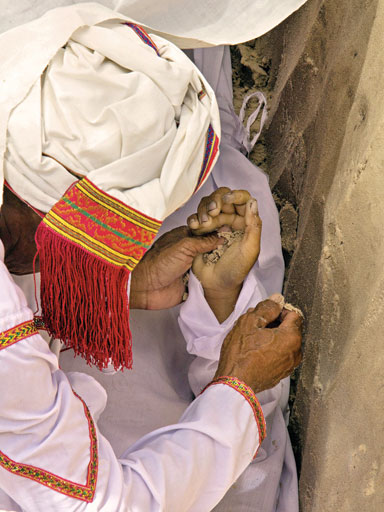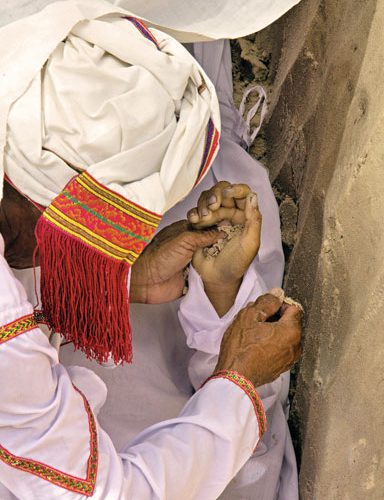(No.8, Vol.6,Oct-Nov 2016 Vietnam Heritage Magazine)
Unlike the Hindu Cham, Bani Cham deceased are brought to the Ghur as soon as possible. A person dying in the morning is interred in the afternoon, or the next morning if the death comes in the afternoon.
In case of an ‘unkind’ death, which means by accident, or while being pregnant or during childbirth, the body would have to be ‘Ba nau paywa’ (consigned). The burying ground is adjacent to the Ghur, but not inside. Two to three years later, when the flesh has completely disintegrated, the relatives unearth the skeleton and perform an official funeral as for a ‘normal’ death.
When a person dies, the clan erects a big tent called Kajang, and the body is washed, and an Acar (priest) is invited to read prayer and shroud it. The shrouded body is then put on an 8-pole bamboo frame, wrapped in two layers of cloths and tied with three ropes. The Imum of the clan leads a group of 6-12 priests, depending on the age of the deceased, and 8 others who carry the frame to the grave. They stop halfway to perform a head-turning ritual and continue their way. Near the Ghur, they stop for four Acar to mount and sit on the frame to say a farewell prayer for the dead person’s soul.
A Ghur is a community cemetery in a Bani Cham village.
Cham people don’t use coffins for burials. The deceased is put into the grave, head pointing north, and body turned sideways facing west. The grave is not heaped up as high as those of the Viet, and has two stones at the head and the feet.
After the rituals at the Ghur, on the way home, no one should look back at the grave because the Cham believe the dead would recognize them and come back to disturb them. Then the official funeral begins. It consists of three rituals: Rop War (Initiation) on the first day, Tak Kabaw Yuw (Buffalo sacrificing) on the second, and Pok Naung (Farwell) on the last day.
On Rop War day they simply consecrate a chicken and rice. Priests pray in the Kajang and the family treats visitors with food.
Tak Kabaw Yuw is the most important day. The hosts buy a buffalo for the priest to perform the sacrificial ritual and to treat the clan and visitors. That night, almost everybody stays awake to discuss the next ritual and to keep the funeral company.
Finally, on Pok Naung, they make a farewell to the deceased. The ritual takes place in the morning. The relatives bring a lot of offerings in trays and arrange in front of the Kajang. A priest reads prayers. The relatives take turn to come inside the Kajang to kowtow. The clan member who knows the Koran best recites some verses to Allah to ask for the soul of the deceased to get to nirvana. Finally clan members take offerings in straw baskets out of the Kajang and stand in two lines. The Imum leads the priests and relatives in a procession, carrying the offerings, to a crossroad, where they stop for the priests to pray and perform the funeral ending ritual.
Two days after the main funeral, the family of the deceased goes to a river and gets two stones and ask an Acar for blessing to put on the new grave. Like those of the Hindu Cham, the Bani Cham graves don’t have a name plate. The two stone indicate that a Bani Cham person has ‘come home’ forever.
At the beginning off every Ramadan, the month of fasting, an Acar comes to the Ghur with the clan to visit the graves and perform consecration rituals. After that they perform many other rituals at home for the whole month.
A Bani Cham cemetery is just about half a kilometre from the village, far from the noise of human activities but still accessible. Along the shores off Ninh Thuan and Binh Thuan provinces there are a few Ghur over 200 years old. For social reasons, the Cham have left the sea to live on the plains. They have established new Ghur to bury the dead. But unlike the Hindu Cham, the Bani Cham still visit the old Ghur every Ramadan, although these are no longer used for new burials. They say, first one should visit the ‘far Ghur’ then visit the ‘near Ghur’.
*The author is a poet and Cham cultural researcher
Photos: A funeral of Cham Bani taken by Ngo Quang Phuc in Phan Ri, Binh Thuan Province, 2013





